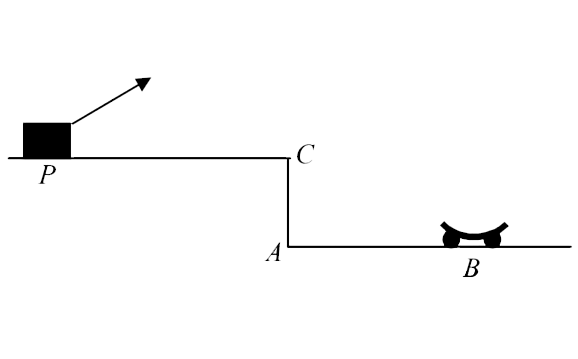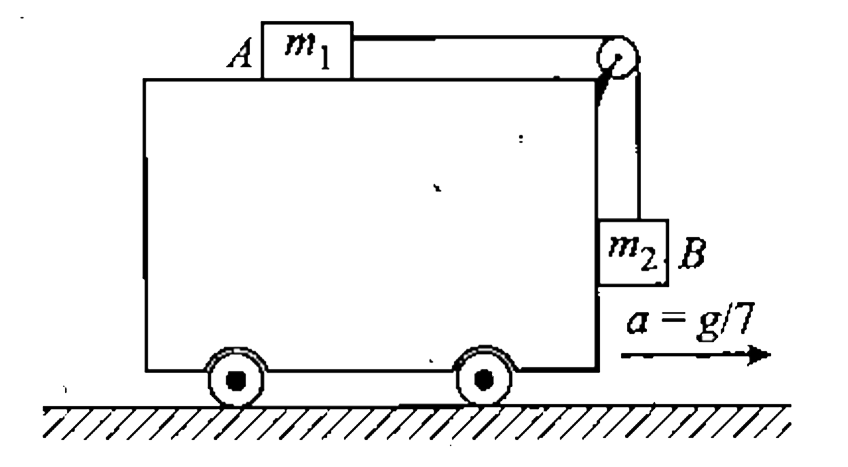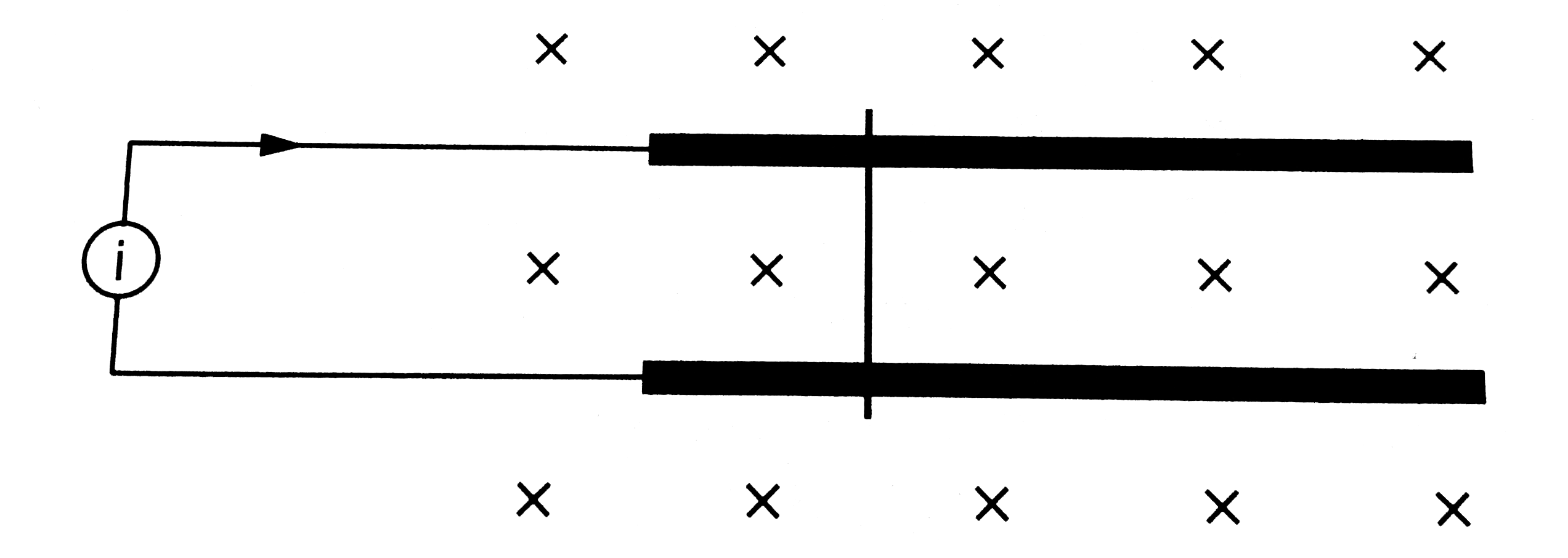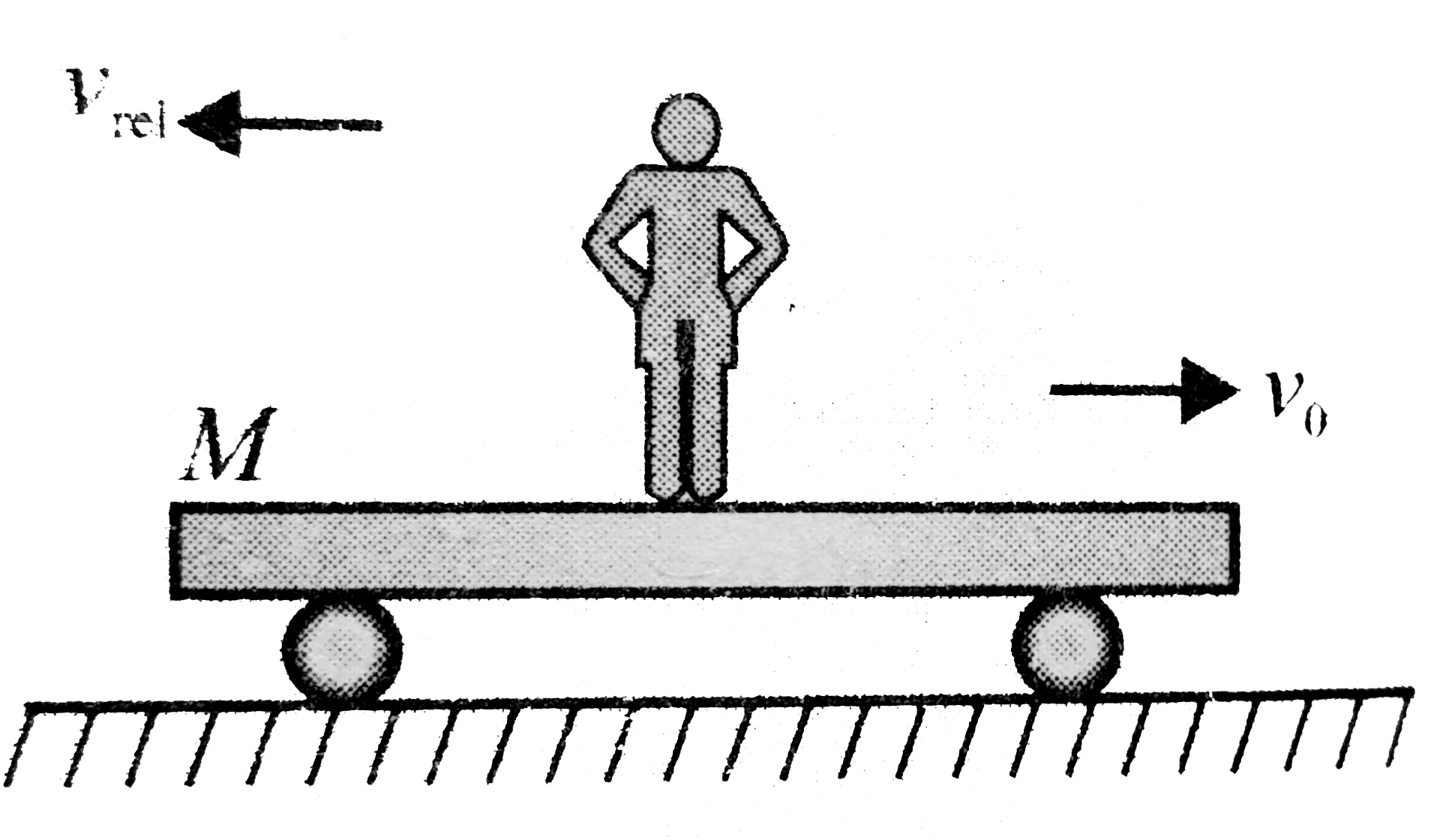A carriage closed on all sides stands on rails. Can the :passengers inside the carriage cause an oscillatory motion of the carriage? Friction with the rails should be neglected. The mass of the carriage should be assumed to be commensurate with that of the passengers.
The correct Answer is:Hint. Make use of the properties of the centre of mass ( 15.8).
Yes, they can, for instance, by running periodically from one end of the car to the other and back.
Similar Questions
A car P is moving with a uniform speed 5√3m/s towards a carriage of mass 9 kg at rest kept on the rails at a point B as shown in figure. The height AC is 120 m. Cannon balls of 1 kg are fired from the car with an initial velocity 100m/s at an angle 30∘ with the horizontal. The first cannon hall hits the stationary carriage after a timet0 and sticks to it. Determine t0.

At t0, the second cannon ball is fired. Assume that the resistive force between the rails and the carriage is constant and ignore the vertical motion of the carriage throughout. If the second ball also hits and sticks to the carriage, what will be the horizontal velocity of the carriage just after the second impact?
View SolutionA car P is moving with a uniform speed 5√3m/s towards a carriage of mass 9 kg at rest kept on the rails at a point B as shown in figure. The height AC is 120 m. Cannon balls of 1 kg are fired from the car with an initial velocity 100m/s at an angle 30∘ with the horizontal. The first cannon hall hits the stationary carriage after a timet0 and sticks to it. Determine t0.

At t0, the second cannon ball is fired. Assume that the resistive force between the rails and the carriage is constant and ignore the vertical motion of the carriage throughout. If the second ball also hits and sticks to the carriage, what will be the horizontal velocity of the carriage just after the second impact?
View SolutionIn how many ways can eight passengers be accommodated in three railway carriages if eac carriage can accommodate any number of passengers.
View SolutionDirections: In the question given below a statements is followed by three courses of action numbered I or (A), II or (B) and III or (C). A course of action is a step or administrative decision to be taken for improvement, follow-up for further action in regards to the problem, policy etc. on the basis of the information given in the statement. you have to assume everything in the statement to be true, then decide which of the three given/suggested courses of action logically follows for pursuing and decide the answer.
Statement: Because of the large number of people who want to enjoy summer vacation ,the railways has fails to satisfy the demands for tickets to various destinations for the enjoyers.
Course of action :I. The railways should make additional arrangement of trains so that the demands can be fulfilled .
II.A helpline for aspirants should be set up.
III.The rail fare should be increased to such a limit that the number of aspirants reduces to the existing capacity of trains.
1) Only I and II follows
2)Only II and III follow
3) None follows.
4) All follow
5) None of these.
View SolutionA railway carriage of mass Mc filled with sand of mass Ms moves along the rails. The carriage is given an impulse and it starts with a velocity v0. At the same time it is observed that the sand starts leaking through a hole at the bottom of the carriage at a constant mass rate λ. Find the distance at which the carriage becomes empty and the velocity attained by the carriage at that time. (Neglect the friction along the rails).
View SolutionA railway carriage of mass Mc filled with sand of mass Ms moves along the rails. The carriage is given an impulse and it starts with a velocity v0. At the same time it is observed that the sand starts leaking through a hole at the bottom of the carriage at a constant mass rate λ. Find the distance at which the carriage becomes empty and the velocity attained by the carriage at that time. (Neglect the friction along the rails).
View SolutionTwo blocks of masses m1 and m2 respectively are connected by an inextensible and weight less string which passes over a smooth and light pulley fixed at the top comer of a long carriage.The upper surface of the carriage is friction less and the body Å rests on it. B hangs vertically in contact with the rough vertical side of the carriage. The carriage moves with an acceleration gH towards right hand side as shown in figure-2.79. If the blocks remain stationary with respect to the carriage and m1=7.5m2, calculate the coefficient of friction between the block B and vertical side of the carriage.

View SolutionShows two long metal rails placed horizontally and parallel to each other at a separation i. A uniform magnetic field b exists in the vertically downward direction. A wire of mass m can slide on the rails. The rails are connected to a constant current source which drives a current I in the circuirt. The friction coefficient between the rails and the wire is μ. (a) What should be the minimum value of μ which can prevent the wire from sliding on the rails? (b) Describe the motion of the wire if the value of μ is half the value found in the previous part.

View SolutionShows two long metal rails placed horizontally and parallel to each other at a separation i. A uniform magnetic field b exists in the vertically downward direction. A wire of mass m can slide on the rails. The rails are connected to a constant current source which drives a current I in the circuirt. The friction coefficient between the rails and the wire is μ. (a) What should be the minimum value of μ which can prevent the wire from sliding on the rails? (b) Describe the motion of the wire if the value of μ is half the value found in the previous part.

View Solutiona. A rail road flat car of mass M can roll without friction along a straight horizontal track . Initially, a man of mass m is standing on the car which is moving to the right with speed v0. What is the change in velocity of the car if the man runs to the left so that his speed relative to the car is vrel just before he jumps off at the left end?
b. If there are n men each of mass m on the car, should they all run and jump off together or should they run and jump one by one in order to give a greater velocity to the car?

View Solution
